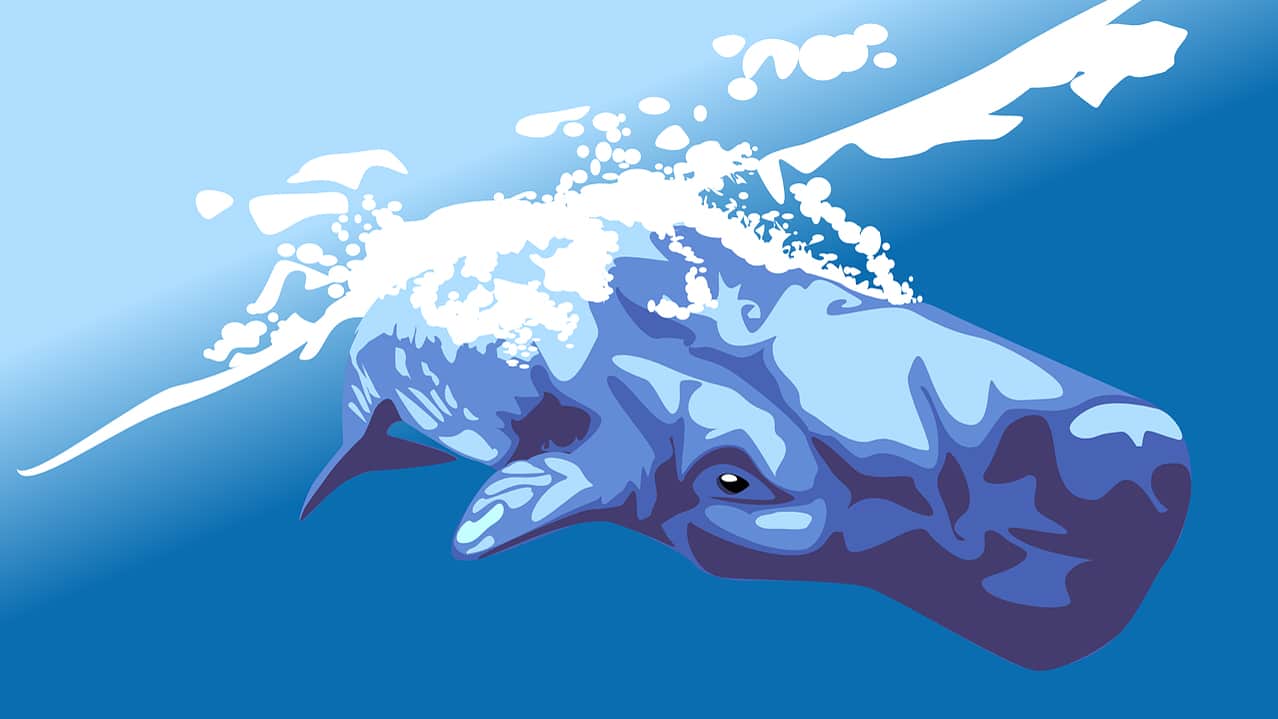Marine Life & Conservation Blogs
Sperm Whales

A guest blog from Isobel Fairbairn
Moby Dick’s own antagonist, Sperm Whales (Physeter macrocephalus) are one of the oceans most elusive creatures.
These creatures must be hoarding more knowledge than the board of NASA, as they carry one of the largest brains on earth all bundled up inside one of the largest, heaviest heads! It is also thought that alongside these brains, carried around in the head is Spermaceti, once thought to be a stream of sperm it is now assumed to be a liquid that helps with buoyancy.
Now all this odd sounding liquid would be needed for buoyancy as sperm whales spend a lot of their time diving; although they can weigh between 35-45 tonnes, they can dive over 7000 feet. While down, they can hold their breath for up to 90 minutes; I’ve only just started out my scuba diving training but the idea of being under water for that long is a marvel to me…and I’m thinking with our heavy kit, imagine carrying their head on your shoulders! I guess sperm whales also don’t need to learn hand signals while diving either, aside from the fact they have wonderful methods of communication, “O.K?” hand signals may be quite hard sans fingers.
I think sperm whales diving ability makes them one of my favourite creatures, on top of that, have you ever seen a sperm whale sleep? Eerily haunting. A seemingly magnificent sighting. Something I could only dream of seeing up close. The notion that these giant-like creatures can simply stop and hang like icicles is almost unbelievable.
It’s not only their diving abilities that makes sperm whales stand out so much in my eyes, but also their incredible ability to communicate. Now maybe this Is because I was talking before I could walk and, as my mother says, haven’t stopped since, but these whales have a broad, potentially in-depth “language” that they, similarly to us, learn from their parents.
Unlike many mammals the sperm whales form of communication stretches beyond just primal needs and urges. Sperm whales seem to interact with one another in many ways; body language combined with vocalisation, researchers and journalists alike have seen these whales act like tight knit friends or family, with closeness and familiarity between them uncanny to our own. Brothers have been seen almost conversing, playing around together for extended periods of time, young calves have been seen being scolded by parental figures.
Not only does their communication give us an insight into their complex nature, but the way they spend their lives does. The calves’ tendencies to stay with the mother throughout, staying in pods with the females and the males tendencies to leave the pod around 4 years old but then often going and starting their own family eventually, shows us even deeper into their nature.
Their emotional depth, the relationship they have with others, their own family and even how they can adapt their tones to interact with strangers is enlightening. I’m sure there’s a lot we can learn from sperm whales, and I hope we never stop trying to learn from them or about them.
These mere interactions give us an insight into the incredible beings that are sperm whales, and the intricate lives they lead. The emotional depth we’ve already seen whales express over the years gives me an intense feeling of connection to our world, the oceans and the incredible creatures that inhabit them. That we have an honour to share the earth with these animals alone is one thing, that they allow us even a small view into their world is another.
 Isobel Fairbairn is a 22 year old first year Marine Biology student at the university of Salford with a passion for both writing and marine life. “I loves to share things that I learn along my journey and that’s when I decided I wanted to take my career towards writing, I’ve always wanted to write but when my two passions collided I knew I had to go in this direction.”
Isobel Fairbairn is a 22 year old first year Marine Biology student at the university of Salford with a passion for both writing and marine life. “I loves to share things that I learn along my journey and that’s when I decided I wanted to take my career towards writing, I’ve always wanted to write but when my two passions collided I knew I had to go in this direction.”Marine Life & Conservation Blogs
Creature Feature: Dusky Shark

 In this series, the Shark Trust will be sharing amazing facts about different species of sharks and what you can do to help protect them.
In this series, the Shark Trust will be sharing amazing facts about different species of sharks and what you can do to help protect them.
This month we’re taking a look at the Dusky Shark, a highly migratory species with a particularly slow growth rate and late age at maturity.
Dusky sharks are one of the largest species within the Carcharhinus genus, generally measuring 3 metres total length but able to reach up to 4.2 metres. They are grey to grey-brown on their dorsal side and their fins usually have dusky margins, with the darkest tips on the caudal fin.
Dusky Sharks can often be confused with other species of the Carcharhinus genus, particularly the Galapagos Shark (Carcharhinus galapagensis). They have very similar external morphology, so it can be easier to ID to species level by taking location into account as the two species occupy very different ecological niches – Galapagos Sharks prefer offshore seamounts and islets, whilst duskies prefer continental margins.
Hybridisation:
A 2019 study found that Dusky Sharks are hybridising with Galapagos Sharks on the Eastern Tropical Pacific (Pazmiño et al., 2019). Hybridisation is when an animal breeds with an individual of another species to produce offspring (a hybrid). Hybrids are often infertile, but this study found that the hybrids were able to produce second generation hybrids!
Long distance swimmers:
Dusky sharks are highly mobile species, undertaking long migrations to stay in warm waters throughout the winter. In the Northern Hemisphere, they head towards the poles in the summer and return southwards towards the equator in winter. The longest distance recorded was 2000 nautical miles!
Very slow to mature and reproduce:
The Dusky Shark are both targeted and caught as bycatch globally. We already know that elasmobranchs are inherently slow reproducers which means that they are heavily impacted by overfishing; it takes them so long to recover that they cannot keep up with the rate at which they are being fished. Dusky Sharks are particularly slow to reproduce – females are only ready to start breeding at roughly 20 years old, their gestation periods can last up to 22 months, and they only give birth every two to three years. This makes duskies one of the most vulnerable of all shark species.
The Dusky Shark is now listed on Appendix II of the Convention on the Conservation of Migratory Species (CMS), but further action is required to protect this important species.
Scientific Name: Carcharhinus obscurus
Family: Carcharhinidae
Maximum Size: 420cm (Total Length)
Diet: Bony fishes, cephalopods, can also eat crustaceans, and small sharks, skates and rays
Distribution: Patchy distribution in tropical and warm temperate seas; Atlantic, Indo-Pacific and Mediterranean.
Habitat: Ranges from inshore waters out to the edge of the continental shelf.
Conservation status: Endangered.
For more great shark information and conservation visit the Shark Trust Website
Images: Andy Murch
Diana A. Pazmiño, Lynne van Herderden, Colin A. Simpfendorfer, Claudia Junge, Stephen C. Donnellan, E. Mauricio Hoyos-Padilla, Clinton A.J. Duffy, Charlie Huveneers, Bronwyn M. Gillanders, Paul A. Butcher, Gregory E. Maes. (2019). Introgressive hybridisation between two widespread sharks in the east Pacific region, Molecular Phylogenetics and Evolution 136(119-127), https://doi.org/10.1016/j.ympev.2019.04.013.
Marine Life & Conservation Blogs
Creature Feature: Undulate Ray

 In this series, the Shark Trust will be sharing amazing facts about different species of sharks and what you can do to help protect them.
In this series, the Shark Trust will be sharing amazing facts about different species of sharks and what you can do to help protect them.
This month we’re looking at the Undulate Ray. Easily identified by its beautiful, ornate pattern, the Undulate Ray gets its name from the undulating patterns of lines and spots on its dorsal side.
This skate is usually found on sandy or muddy sea floors, down to about 200 m deep, although it is more commonly found shallower. They can grow up to 90 cm total length. Depending on the size of the individual, their diet can range from shrimps to crabs.
Although sometimes called the Undulate Ray, this is actually a species of skate, meaning that, as all true skates do, they lay eggs. The eggs are contained in keratin eggcases – the same material that our hair and nails are made up of! These eggcases are also commonly called mermaid’s purses and can be found washed up on beaches all around the UK. If you find one, be sure to take a picture and upload your find to the Great Eggcase Hunt – the Shark Trust’s flagship citizen science project.
It is worth noting that on the south coasts, these eggcases can be confused with those of the Spotted Ray, especially as they look very similar and the ranges overlap, so we sometimes informally refer to them as ‘Spundulates’.
Scientific Name: Raja undulata
Family: Rajidae
Maximum Size: 90cm (total length)
Diet: shrimps and crabs
Distribution: found around the eastern Atlantic and in the Mediterranean Sea.
Habitat: shelf waters down to 200m deep.
Conservation Status : As a commercially exploited species, the Undulate Ray is a recovering species in some areas. The good thing is that they have some of the most comprehensive management measures of almost any elasmobranch species, with both minimum and maximum landing sizes as well as a closed season. Additionally, targeting is entirely prohibited in some areas. They are also often caught as bycatch in various fisheries – in some areas they can be landed whilst in others they must be discarded.
IUCN Red List Status: Endangered
For more great shark information and conservation visit the Shark Trust Website
Image Credits: Banner – Sheila Openshaw; Illustration – Marc Dando
-

 News3 months ago
News3 months agoHone your underwater photography skills with Alphamarine Photography at Red Sea Diving Safari in March
-

 News3 months ago
News3 months agoCapturing Critters in Lembeh Underwater Photography Workshop 2024: Event Roundup
-

 Marine Life & Conservation Blogs2 months ago
Marine Life & Conservation Blogs2 months agoCreature Feature: Swell Sharks
-

 Blogs2 months ago
Blogs2 months agoMurex Resorts: Passport to Paradise!
-

 Blogs2 months ago
Blogs2 months agoDiver Discovering Whale Skeletons Beneath Ice Judged World’s Best Underwater Photograph
-

 Gear Reviews3 months ago
Gear Reviews3 months agoGear Review: Oceanic+ Dive Housing for iPhone
-

 Marine Life & Conservation2 months ago
Marine Life & Conservation2 months agoSave the Manatee Club launches brand new webcams at Silver Springs State Park, Florida
-

 News3 months ago
News3 months agoWorld’s Best Underwater Photographers Unveil Breathtaking Images at World Shootout 2023






















